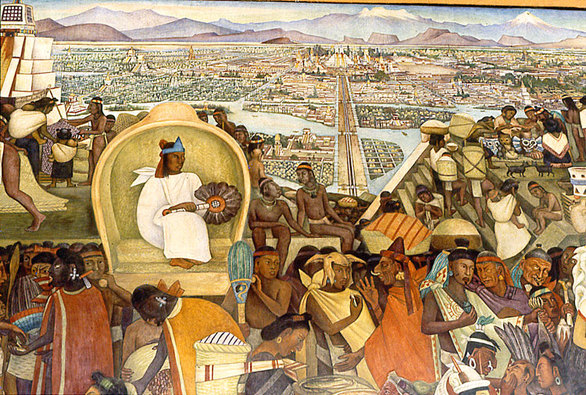1.3.2 Elodie Chidiac, Jessalyn Nelson, Karen Angeles, Jazmin Haque, Helen Fertal
Author: Jazmin Haque
Basic Gist
Novgorod
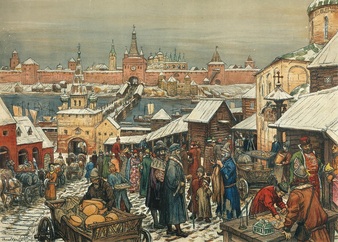
Novgorod had been a large trade city and cultural center of medieval Europe. Located in Russia, the trade city had been founded in 862. Novgorod had been a chief center of foreign trade for Russia. It had contributed large economic prosperity during the late 10th century into it’s height in the 14th century. The city had been located on the trade route to the Volga valley. Its major exports had been furs, hides, wax, honey, flax, and tar. In addition, cloth and metals had been imported from Europe along with corn from central Russia. Silver and gold had been imported in the form of coins into the city from the German’s and Europeans. Central Asian trade had also been seen. Expanded trade had impacted the city by allowing it to grow and prosper. During the 14th century there had been hundreds of churches, arsenals, fairs, and shops that had been constructed. There had also been tremendous population increases due to trade in the city.
The city of Novgorod was very busy with merchants
trading their goods from around the world.
trading their goods from around the world.
Privileges Granted to German Merchants at Novgorod, 1229
An early association of Hamburg, Lübeck, and Wisby obtained a factory and privileges in the city of Novgorod, the western terminus of the northern caravan route from Asia. This association, however, should not be considered as the Hanseatic League in the fullest sense of the term, though the regulations quoted in this grant may have contributed to the formation of Hanseatic Law.
“In the name of God, Amen. Be it known to all the faithful of Christ seeing these presents, that according to the charters possessed in time past by the merchants living among the Ruthenians at Novgorod, the following rights and privileges of theirs are known to have existed.... When the merchants of Germany or Gothland come to Birken Island in the realm of the King of Novgorod, they will be under the peace and protection of the King and citizens of Novgorod; and the citizens of Novgorod will be responsible for whatever injury is inflicted upon them in the dominion of Novgorod And the said merchants will have the same peace and protection both in going to their homes, and in leaving them. Moreover, when the merchants come to the water which is called Nü, they will enjoy the same liberty which they have had in all things in time past."
This document explains that the merchants that had come to Novgorod were allowed peace and had protection in exchange for their trades. These laws in effect had allowed for merchants to successful trade peacefully which had created wealth in the city due to more trade exchanges.
“In the name of God, Amen. Be it known to all the faithful of Christ seeing these presents, that according to the charters possessed in time past by the merchants living among the Ruthenians at Novgorod, the following rights and privileges of theirs are known to have existed.... When the merchants of Germany or Gothland come to Birken Island in the realm of the King of Novgorod, they will be under the peace and protection of the King and citizens of Novgorod; and the citizens of Novgorod will be responsible for whatever injury is inflicted upon them in the dominion of Novgorod And the said merchants will have the same peace and protection both in going to their homes, and in leaving them. Moreover, when the merchants come to the water which is called Nü, they will enjoy the same liberty which they have had in all things in time past."
This document explains that the merchants that had come to Novgorod were allowed peace and had protection in exchange for their trades. These laws in effect had allowed for merchants to successful trade peacefully which had created wealth in the city due to more trade exchanges.
Timbuktu

Timbuktu is a city in the African country of Mali that is located near the Niger River. After being founded during the 12th century, Timbuktu had soon become a large trading city for the caravans and travelers in the Sahara Desert. In the 14th century there had been a legend of Timbuktu as a rich cultural trade center, it had been known as an “African El Dorado” or a city made of gold. Of course, the homes were never actually made of gold but by the 15th century the importance of Timbuktu had grown immensely. While there had been few goods that had actually been produced in Timbuktu, it was more widely known as a large trade center for salt trade. Also, it had been a large center of Islamic study. The cities maximum population of 50,000 to 100,000 had been comprised of 25% scholars and students during the 1400s. Trade had allowed for Timbuktu to grow as a large cultural trade center. This had allowed for education and technology to become abundant and advance.
This picture illustrates merchants traveling on camel to
the city of Timbuktu. Through the Sahara desert was their
main route. The lavish temples and architecture can be
seen in the background of the picture which shows how
Timbuktu had been depicted: a wealthy, amazing city.
This picture illustrates merchants traveling on camel to
the city of Timbuktu. Through the Sahara desert was their
main route. The lavish temples and architecture can be
seen in the background of the picture which shows how
Timbuktu had been depicted: a wealthy, amazing city.
Leo Africanus: Description of Timbuktu from The Description of Africa (1526)
El Hasan ben Muhammed el-Wazzan-ez-Zayyati was born in the Moorish city of Granada in 1485, but was expelled along with his parents and thousands of other Muslims by Ferdinand and Isabella in 1492. Settling in Morocco, he studied in Fez, and as a teenager accompanied his uncle on diplomatic missions throughout North Africa and and to the Sub-Saharan kingdom of Ghana. Still a young man, he was captured by Christian pirates and presented as an exceptionally learned slave to the great Renaissance pope, Leo X. Leo freed him, baptised him under the name "Johannis Leo de Medici," and commissioned him to write in Italian the detailed survey of Africa which provided most of what Europeans knew about the continent for the next several centuries. At the time he visited the Ghanaian city of Timbuktu, it was somewhat past its peak, but still a thriving Islamic city famous for its learning. "Timbuktu" was to become a byword in Europe as the most inaccessible of cities, but at the time Leo visited, it was the center of a busy trade in African products and in books. Leo is said to have died in 1554 in Tunis, having reconverted to Islam.
“The royal court is magnificent and very well organized. When the king goes from one city to another with the people of his court, he rides a camel and the horses are led by hand by servants. If fighting becomes necessary, the servants mount the camels and all the soldiers mount on horseback. When someone wishes to speak to the king, he must kneel before him and bow down; but this is only required of those who have never before spoken to the king, or of ambassadors. The king has about 3,000 horsemen and infinity of foot-soldiers armed with bows made of wild fennel which they use to shoot poisoned arrows. This king makes war only upon neighboring enemies and upon those who do not want to pay him tribute. When he has gained a victory, he has all of them--even the children--sold in the market at Timbuktu."
Leo Africanus' description of Timbuktu explains the extravagance of the city and the king of the city. The trade market of Timbuktu had been the key to the lavish living and strong military that the king had.
“The royal court is magnificent and very well organized. When the king goes from one city to another with the people of his court, he rides a camel and the horses are led by hand by servants. If fighting becomes necessary, the servants mount the camels and all the soldiers mount on horseback. When someone wishes to speak to the king, he must kneel before him and bow down; but this is only required of those who have never before spoken to the king, or of ambassadors. The king has about 3,000 horsemen and infinity of foot-soldiers armed with bows made of wild fennel which they use to shoot poisoned arrows. This king makes war only upon neighboring enemies and upon those who do not want to pay him tribute. When he has gained a victory, he has all of them--even the children--sold in the market at Timbuktu."
Leo Africanus' description of Timbuktu explains the extravagance of the city and the king of the city. The trade market of Timbuktu had been the key to the lavish living and strong military that the king had.
Swahili City-States
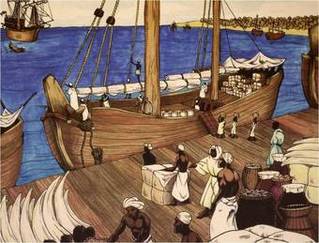
During 1000 to 1500 there had been a large number of city-states on the eastern coast of Africa that had taken part in an international trade network. The city-states had been known as the Swahili City-States and had stretched over 1,500 miles in Africa. These trade cities had gone from agricultural villages to wealthy towns and cities. Trade had allowed for these cities to change the structure of society. The incoming wealth had created an elite merchant class. Much of this wealth had come from Indian Ocean trade. In addition, the city-states had traded with Persia, India, and China. Many natural resources had been traded to these places. Merchants had traded ivory, gold, textiles, and copper. In addition all of the states had produced pottery. Iron working had been used in East Africa before the prime of the city-states. They had improved iron working processes and had produced iron objects for trade and local use. In all, it can be seen that long distance trade and exports had allowed for small agricultural villages to transform into wealthy trade cities.
A port at Kilwa (one of Swahili's city-state's) allows for
trade and commerce along the Indian ocean.
trade and commerce along the Indian ocean.
Hangzhou
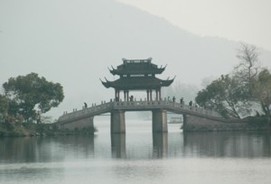
The city of Hangzhou was founded in the year 606. During the Southern Song dynasty from 1132 to 1276 it had been a large trade city. Hangzhou was rich in silk trade, a large center or art, literature, and had a large population that also consisted of many foreign merchants. These merchants had been Arabs, Persians, and even Christians. The famous merchant, Marco Polo, had even described it as “the finest and noblest city in the world” after visiting it. There had been many beautiful monasteries, shrines, and buildings that had been constructed during this time. Local industries had prospered at this time due to trade. In addition, Buddhism and Taoism had grown and flourished at this time. Trade had allowed for Hangzhou to increase it’s wealth and subsequently allowed for China’s economy to thrive in the Southern Song Dynasty’s capital city.
The city of Hanzhou was beautifully constructed
as seen through bridges and temples.
as seen through bridges and temples.
Calicut

Calicut had been a city in the southwestern region of India on the Malabar coast of the Arabian Sea. This had been one of the leading ports of south India during the mid 1400s to early 1500s, however, it had declined during the 19th century. The city had been known as a center for European traders. Coconuts, spices, tea, and coffee had been exported from India from Calicut. Goods that had been produced and traded with from Calicut had been cotton cloth, wood products, tiles, and hosiery. Extensive trade had impacted Calicut by allowing the city and its economy to grow. It had also allowed for new products and technologies to enter India.
Calicut had been a booming, busy trade city that had
merchants come from around the world by sea in order
to trade their goods.
merchants come from around the world by sea in order
to trade their goods.
Vasco da Gama: Round Africa to India, 1497-1498 CE Diary Excerpt
"On the following day (May 22) these same boats came again alongside, when the captain-major sent one of the convicts to Calicut, and those with whom he went took him to two Moors from Tunis, who could speak Castilian and Genoese. The first greeting that he received was in these words: "May the Devil take thee! What brought you hither?" They asked what he sought so far away from home, and he told them that we came in search of Christians and of spices. They said: "Why does not the King of Castile, the King of France, or the Signoria of Venice send thither?" He said that the King of Portugal would not consent to their doing so, and they said he did the right thing. After this conversation they took him to their lodgings and gave him wheaten bread and honey. When he had eaten he returned to the ships, accompanied by one of the Moors, who was no sooner on board, than he said these words: "A lucky venture, a lucky venture! Plenty of rubies, plenty of emeralds! You owe great thanks to God, for having brought you to a country holding such riches!" We were greatly astonished to hear his talk, for we never expected to hear our language spoken so far away from Portugal."
This document explains the riches that had been present in Calicut which had been discovered by Vasca da Gama as he went to India. These riches had been gained due to successful trades with other countries.
This document explains the riches that had been present in Calicut which had been discovered by Vasca da Gama as he went to India. These riches had been gained due to successful trades with other countries.
Baghdad
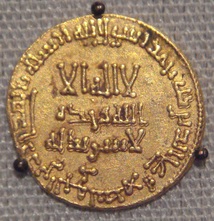
Baghdad had been the capital of the Muslim world of the Abbasid dynasty. Located near the Tigris river, from the middle of the 8th century to the late 13th century, the city had prospered into the world’s major center of education and culture. At this time the Islamic civilization was in a “Golden Age”. The items that had been imported into the city had been basic needs like grain, metals, and wood. In addition, imports from one region were commonly used as exports to another such as pearls from the gulf, and cloth. Medicines, the Abbasid’s advances in medical science, paper, and sugar was also traded at this time period. Long distance trade had allowed for the city to become a center of education and culture because of the many ideas and people that came throughout the city. Medicine, mathematics, chemistry, literature, and astronomy had been highly studied and in effect, much important advancement had been made in these fields. Baghdad had also become a city full of museums, hospitals, libraries, and mosques due to trade. Trade had allowed for much wealth to be obtained and in turn helped changed the city tremendously.
Coins similar to this were used in
Baghdad as currency.
Baghdad as currency.
Yakut: Baghdad under the Abbasids, c. 1000 CE
Baghdad "the city of the Arabian nights" was founded in 764 CE. by the Abbasid Caliph Al-Mansur. It was in its prime about 800 CE., during the reign of the famous caliph Harun-al-Rashid. What this city - which represented the crown of Medieval Muslim civilization - resembled, is told by an author who saw Baghdad in its glory.
"The city of Baghdad formed two vast semi-circles on the right and left banks of the Tigris, twelve miles in diameter. The numerous suburbs, covered with parks, gardens, villas and beautiful promenades, and plentifully supplied with rich bazaars, and finely built mosques and baths, stretched for a considerable distance on both sides of the river. In the days of its prosperity the population of Baghdad and its suburbs amounted to over two millions! The palace of the Caliph stood in the midst of a vast park several hours in circumference which beside a menagerie and aviary comprised an inclosure for wild animals reserved for the chase. The palace grounds were laid out with gardens, and adorned with exquisite taste with plants, flowers, and trees, reservoirs and fountains, surrounded by sculptured figures. On this side of the river stood the palaces of the great nobles. Immense streets, none less than forty cubits wide, traversed the city from one end to the other, dividing it into blocks or quarters, each under the control of an overseer or supervisor, who looked after the cleanliness, sanitation and the comfort of the inhabitants."
This document exemplifies how Baghdad had been seen by others. It supports the idea that the city had been extravagant due to its wealthy trade economy.
"The city of Baghdad formed two vast semi-circles on the right and left banks of the Tigris, twelve miles in diameter. The numerous suburbs, covered with parks, gardens, villas and beautiful promenades, and plentifully supplied with rich bazaars, and finely built mosques and baths, stretched for a considerable distance on both sides of the river. In the days of its prosperity the population of Baghdad and its suburbs amounted to over two millions! The palace of the Caliph stood in the midst of a vast park several hours in circumference which beside a menagerie and aviary comprised an inclosure for wild animals reserved for the chase. The palace grounds were laid out with gardens, and adorned with exquisite taste with plants, flowers, and trees, reservoirs and fountains, surrounded by sculptured figures. On this side of the river stood the palaces of the great nobles. Immense streets, none less than forty cubits wide, traversed the city from one end to the other, dividing it into blocks or quarters, each under the control of an overseer or supervisor, who looked after the cleanliness, sanitation and the comfort of the inhabitants."
This document exemplifies how Baghdad had been seen by others. It supports the idea that the city had been extravagant due to its wealthy trade economy.
Malacca

Malacca had been located on the Malay Peninsula. Through trade, the city had successfully grown. Malacca had been prosperous from 600 to 1450 along the Silk Road, Spice routes, and few sea roads, which had goods imported and exported to the city. Its neighbors had a large influence on converting the city to Islam and rendering different languages and cultures. Due to an increase in cultural and religious influence, the ample supply of goods being traded, and valuable geographical position, it had become a powerful city that had traded and interacted with much of the rest of the world. Due to Malacca’s successful trade relations, it was able to construct many mosques, churches, and temples, of which all had advanced artwork and architecture. These buildings had added to the advancement and success of the city. The success of Malacca had started soon after being founded making it a large international port city. Its location itself was extremely important and had contributed to its success. Malacca was located in-between Malaysia and Singapore.
Western and Eastern civilizations had traded through it including the
Chinese Empire, Siamese, Gujarat, Arabs, and Europeans.
Western and Eastern civilizations had traded through it including the
Chinese Empire, Siamese, Gujarat, Arabs, and Europeans.
Malacca was a very powerful port city that had many
extravagant temples and buildings.
extravagant temples and buildings.
Venice
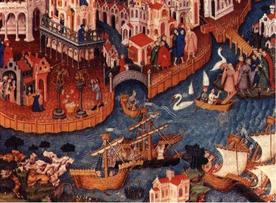
Venice, located in Italy, had been known for its large trade centers and textile industry. The city had connected the Western world with the East. The key to its success was its location, which had given it an advantage over all of the other trade ports in Italy. Before the Renaissance, Venice had trade with the Islamic world. Later during the 1200s trade had been established between Egypt, Syria, Southeast Asia, Iran, and China. Spice trade from the east had been the prime reason for their high quality textile manufacturing. Textiles had been exchanged for spices from the east. Venice had flourished in the trading industry due to its accessibility to labor, raw materials, and a good economy (which had been because of successful trades). Trade relations between the Mongol Empire, Persia, Armenia, and Caucasus had allowed for the city to obtain many goods such as porcelain, pearls, gems, mineral dyes, peacock feathers, and textiles like silks, cottons, and brocades.
Venice had been a very busy and popular trade
city during the 1200s. Merchants had come
from many different areas of the world to
trade their goods which had allowed for the city
to be constructed beautifully.
city during the 1200s. Merchants had come
from many different areas of the world to
trade their goods which had allowed for the city
to be constructed beautifully.
Tenochtitlan
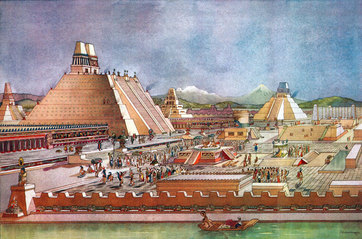
Tenochtitlan had been one of the largest cities of the Aztec culture. It had been located in today’s Mexico City. The city itself is located on a marsh in a lake bottom which is then ringed by mountains. This area had been prone to earthquakes. It had been founded in 1325. During the 14th and 15th centuries the city had grown and prospered. There had been canals that criss crossed throughout the city and there had been floating gardens had surrounded the city. During its height it had been the leader of trade in Mexico’s basin. They had joined an alliance with their neighbors which had contributed to its success as a trade city. A large marketplace in the city had supplied about 60,000 people daily. The Sacred Precinct of the city housed large, beautiful palaces and temples.The city had been known for its imports and exports of obsidian, bronze, copper, and ceramics. Trade had allowed for Tenochtitlan to grow as a city and strengthen its economy which had allowed for many complex goods to be created.
The architecture in Tenochtitlan had been superb, these
great feats were allowed because of the large amounts
of trade that had brought wealth into the city.
great feats were allowed because of the large amounts
of trade that had brought wealth into the city.
Hernan Cortés: from Second Letter to Charles V, 1520:
"Among these temples there is one which far surpasses all the rest, whose grandeur of architectural details no human tongue is able to describe; for within its precincts, surrounded by a lofty wall, there is room enough for a town of five hundred families. Around the interior of the enclosure there are handsome edifices, containing large halls and corridors, in which the religious persons attached to the temple reside. There are fully forty towers, which are lofty and well built, the largest of which has fifty steps leading to its main body, and is higher than the tower of the principal tower of the church at Seville. The stone and wood of which they are constructed are so well wrought in every part, that nothing could be better done, for the interior of the chapels containing the idols consists of curious imagery, wrought in stone, with plaster ceilings, and wood-work carved in relief, and painted with figures of monsters and other objects. All these towers are the burial places of the nobles, and every chapel in them is dedicated to a particular idol, to which they pay their devotions."
This primary source document is Cortes' description of Tenochtitlan and his conquest of the Aztecs. Cortes describes the city as wealthy and beautiful with many amazing temples and architectural feats. He also describes in his accounts about the trade markets and how successful they are.
This primary source document is Cortes' description of Tenochtitlan and his conquest of the Aztecs. Cortes describes the city as wealthy and beautiful with many amazing temples and architectural feats. He also describes in his accounts about the trade markets and how successful they are.
Works Cited
"Aztec Culture: The Aztec Capital City Of Tenochtitlan." About.com Archaeology. About.com, n.d. Web. 20 Dec. 2012.
"Baghdad." Baghdad. N.p., n.d. Web. 20 Dec. 2012.
"Baghdad in Islamic History." About.com Islam. N.p., n.d. Web. 20 Dec. 2012.
"East African City States | The Black Past: Remembered and Reclaimed." East African City States | The Black Past: Remembered and Reclaimed. N.p., n.d. Web. 20 Dec. 2012.
"Economy and Trade - Tenochtitlan." Economy and Trade - Tenochtitlan. N.p., n.d. Web. 20 Dec. 2012.
"Hangzhou." Encyclopedia.com. N.p., n.d. Web. 20 Dec. 2012. <http://www.encyclopedia.com/topic/Hangzhou.aspx>.
"History of Calicut." History of Calicut. N.p., n.d. Web. 20 Dec. 2012.
Infoplease. Infoplease, n.d. Web. 20 Dec. 2012.
"Islamic History in Arabia and Middle East." Islamic History in Arabia and Middle East. N.p., n.d. Web. 20 Dec. 2012.
"Kozhikode Facts." Encyclopedia.com. N.p., n.d. Web. 20 Dec. 2012. <http://www.encyclopedia.com/topic/Kozhikode.aspx>.
"Malacca." Period60910 - Malacca. Wikispaces, n.d. Web. 20 Dec. 2012. <http://period60910.wikispaces.com/Malacca>.
"Novgorod the Great - a Motherland of Russia | Official Site." Novgorod the Great - a Motherland of Russia | Official Site. N.p., n.d. Web. 20 Dec. 2012.
"Timbuktu." About.com Geography. N.p., n.d. Web. 20 Dec. 2012.
"Venice." Venice RSS. N.p., n.d. Web. 20 Dec. 2012.
"Aztec Culture: The Aztec Capital City Of Tenochtitlan." About.com Archaeology. About.com, n.d. Web. 20 Dec. 2012.
"Baghdad." Baghdad. N.p., n.d. Web. 20 Dec. 2012.
"Baghdad in Islamic History." About.com Islam. N.p., n.d. Web. 20 Dec. 2012.
"East African City States | The Black Past: Remembered and Reclaimed." East African City States | The Black Past: Remembered and Reclaimed. N.p., n.d. Web. 20 Dec. 2012.
"Economy and Trade - Tenochtitlan." Economy and Trade - Tenochtitlan. N.p., n.d. Web. 20 Dec. 2012.
"Hangzhou." Encyclopedia.com. N.p., n.d. Web. 20 Dec. 2012. <http://www.encyclopedia.com/topic/Hangzhou.aspx>.
"History of Calicut." History of Calicut. N.p., n.d. Web. 20 Dec. 2012.
Infoplease. Infoplease, n.d. Web. 20 Dec. 2012.
"Islamic History in Arabia and Middle East." Islamic History in Arabia and Middle East. N.p., n.d. Web. 20 Dec. 2012.
"Kozhikode Facts." Encyclopedia.com. N.p., n.d. Web. 20 Dec. 2012. <http://www.encyclopedia.com/topic/Kozhikode.aspx>.
"Malacca." Period60910 - Malacca. Wikispaces, n.d. Web. 20 Dec. 2012. <http://period60910.wikispaces.com/Malacca>.
"Novgorod the Great - a Motherland of Russia | Official Site." Novgorod the Great - a Motherland of Russia | Official Site. N.p., n.d. Web. 20 Dec. 2012.
"Timbuktu." About.com Geography. N.p., n.d. Web. 20 Dec. 2012.
"Venice." Venice RSS. N.p., n.d. Web. 20 Dec. 2012.


